
Wine Culture and Information since 2002 - Volume 22
 Wine Culture and Information since 2002 - Volume 22 |
|
Issue 82, February 2010 |
Contents |
|
|
Back to the Autochthonous |
|
Wine is not a beverage only. Wine is a complex phenomenon for the élite and for marketing, going beyond the simple definition of beverage. It follows fashions and trends, not only the ones concerning taste, but also the ones suggested by a simple opportunism, commercial, of course. Everyone will remember, for example, the fashion, or better to say, the fashions going on in the 1990s, result of past decades: a wine became magically important and of quality in case in the label were written the names of the famous French grapes or the magic barrique. Moreover, barrique was also a word abused by experts or by the ones believed to be experts: by saying “barrique” you were seen as an expert. And the use of barrique made a wine - and maybe it still makes it - of indisputable quality. Wine could have been made with disputable quality methods, but in case it was fermented or aged in barrique, it was a great wine, something even justifying deplorable speculations. The same can be said in case a wine was produced with Chardonnay, Merlot or Cabernet Sauvignon - three magnificent grapes for sure - but they are not enough, alone, to make a great wine. The effects of this fashion have however been deleterious. In all the regions of Italy - each one rich of an unique heritage of grapes - they uprooted local varieties in favor of the new international grapes and to the magic they promised as soon as they were bottled. Then someone started to doubt of all of this magic and started to realize the magnificence of French wines was not only because of their grapes, but also - and first of all - of what they did in vineyard and then in cellar, as well as giving a fundamental importance to the territory, of course. Grape, despite it is important, seemed to be not so important for French vintners. It is not by chance, in France the names of grapes are rarely mentioned in labels; indeed, it is shown the place of origin, the vineyard, the small fraction of a territory. After a long period in which international grapes dominated the scene, in Italy the fashion is now changing by returning back to the autochthonous varieties, to the grapes found in the territory since memorable times. Today when a wine lovers talks about Merlot or Chardonnay, he or she is not considered as an expert, becomes an expert in case he or she mentions - and possibly knows - the autochthonous varieties of every region, including the most obscure and unknown ones. Now that in Italy they realized at last - since many years, to tell the truth - the rich and immense heritage of grapes in our country, a new return back to the autochthonous is taking place: the one of yeast. Wine making technology, with no doubt, has seen an intense and fundamental development in the last 150 years - like never in all of the millenarian history of wine - when the great French scientist Louis Pasteur discovered the secret of fermentation, by identifying the microscopic organisms responsible of this phenomena: yeasts. From that moment on, the studies and researches about these precious micro organisms have been important and fundamental, as to classify the species and the behavior during fermentation. These important researches allowed the selection of the most efficient yeasts for the production of wine, up to making them easily available to the market and therefore usable by anyone who wants to make the beverage of Bacchus, from the home maker to industrial wine makers. As it is commonly known, the fermentation process is not only about the transformation of sugar in alcohol and in other byproducts: this process greatly affects the development of aromas in wine as well. This means that, by using the same type of yeast, the aromas we will find in a glass will smell like the ones of many other wines, just because of the mark given by the yeast. It should also be said yeasts are naturally found in the air and in grape's skin. When the grape is being crushed, yeasts come in contact with the juice, therefore starting fermentation. Not all the yeasts are the same and some of them have such a strong and intense activity and overcome the other strains, including the ones naturally found in a territory. This is what actually happens by using selected yeasts: it is given the wine specific organoleptic qualities by eliminating - as a matter of fact - the action of autochthonous yeasts, the ones naturally found in grape's skin. There are many who say selected yeasts contribute to change environmental conditions naturally offered by the production place, therefore rightly recognizing to the autochthonous yeasts an important role in the definition of the so called terroir. As the yeast greatly contributes to the development of aromas in a wine, as well as contributing to its autochthonous character, today there are many wineries which prefer not to use selected yeasts, therefore favoring the activity of the autochthonous ones found in their territory. Moreover, many wineries have started interesting collaborations with research institutes and universities in order to study the population of autochthonous yeasts found in their estates and cellars, therefore identifying the strains and favoring the development of the most characteristic ones for the fermentation. These researches not only will reevaluate the heritage of autochthonous yeasts of every area, but also the character and terroir, in order to make wines with a better personality and with organoleptic characteristics different from other wines. The contribution of selected yeasts - certainly important - has allowed the creation of similar wines: by using autochthonous yeasts will be enhanced the differences among wines produced with the same varieties even in neighboring areas. The trend of using autochthonous yeasts more and more, will certainly enrich the sensorial experience of tasting, contributing to the creation of truly different wines, while giving an element of typicality and quality. The use of autochthonous yeasts is a characterizing factor, just like any other element or tool used in wine making. In this sense, we'd better not to believe again to the illusion given by the barrique or by international grapes: it would be a mistake to consider a wine made with autochthonous yeasts superior to a wine produced with selected yeasts. In other words, it is not the tool or the technique to make a good result, indeed, it depends by the way they are used. The return back to autochthonous yeasts is however something to be welcome, a new step to make wine distant from the homologation that in the past few years seemed to be the only possible way. In fact, too many wines seemed to be the same like many others. Autochthonous yeast does not promise a striking success, it will certainly contribute to enrich wine with small and big, however significant, differences and characteristics. In conclusion, it also depends on market, as this is the phase in which it is decided what a wine maker will produce. In case a wine produced with autochthonous yeasts does not meet the favor of market, producers will certainly resume using selected yeasts. That's the way the world it is.
|
||||
Comparing Verdicchio and Albana PassitoVerdicchio and Albana are known for their white table wines, however with these grapes are produced very interesting sweet wines |
|
Sweet wines, the ones produced with dried grapes, have always aroused particular interest in every wine lover. Sweet wines are in fact considered precious and valuable, not only for the prices at which they are usually sold - higher than the average price for table wines - but also and above all for the organoleptic richness they express in a glass. The production of sweet wines is mainly about white berried grapes, whereas sweet wine produced with red berried grapes represent a marginal quantity, although prestigious and important. Difficult wines to be produced, not only for the small quantity of juice which can be obtained from grapes, but also for the difficulties found during production, from vineyard to bottle. There are many white berried grapes used in Italy for the production of sweet wines, of them we have chosen two, the two main representative in their respective regions: Albana for Emilia Romagna and Verdicchio for Marches.
|
Albana is a the most famous and known white berried grape of Emilia Romagna and from which are produced dry and sparkling wines as well as sweet wines. Albana is mainly found in the provinces of Forlì-Cesena, Ravenna and Bologna and the wines produced in these areas are classified as Denominazione d'Origine Controllata e Garantita (Denomination of Controlled and Guaranteed Origin, DOCG) - but only in the styles dry and sweet - and it is identified as “Albana di Romagna”. The sparkling style is classified as DOC (Denominazione d'Origine Controllata, Denomination of Controlled Origin) and it is called “Romagna Albana Spumante”. It should be noticed Albana di Romagna, in its two styles dry and sweet, is the only wine of the region to be classified as DOCG. The “dry” style is the one mainly produced and known, whereas the “Passito” style (sweet wine made from dried grapes) is the least common one. The “Passito” style should not be confused with the other two styles “amabile” (off-dry) and “dolce” (sweet), as they are produced with different methods and contain different quantity of residual sugar. Albana di Romagna Passito - the wine we will examine in this comparative tasting - must be produced, according to the disciplinary, with 100% Albana and must have a quantity of sugar, after the drying of grapes, not less that 284 grams per liter, with a yield of grapes in wine not higher than 50%. The drying of grapes is permitted both in the plant - a practice which can favor the development of the noble rot - as well as in mats and the must obtained from the grapes can be vinified and aged in wood casks. Albana di Romagna Passito is also produced in the “riserva” style (reserve) and in this case the quantity of sugar in the must cannot be lesser than 400 grams per liter. Despite the production disciplinary provides for the aging in wood casks, this container is not always used for the production of Albana di Romagna Passito, however this is the most frequent choice.
|
||||||||
|
Verdicchio is one of the most famous and versatile grapes of Marches and Italy. The spreading of this grape is mainly limited to Marches and in particular in the area of Jesi and Matelica, however it is also marginally found in other regions of Central Italy. Verdicchio is one of the grapes protagonists for the rebirth of Italian enology, as it has been one of the first wines to be commercialized in bottle while strongly associating the grape to its territory and to its characteristic “amphora” shaped bottle. Verdicchio has walked a long way rich of success, showing with time - thanks to the job of producers - a wine making versatility like few other white berried grapes of Italy. Today, with Verdicchio are in fact produced many styles of wines, from sparkling to dry, up to “Passito” wines, most of the times with grapes affected by Botrytis Cinerea, the famous noble rot. Among the many styles produced with Verdicchio grape, our comparative tasting will examine the Passito style, in particular, a wine produced with grapes affected by noble rot. In the Marches Verdicchio is used for the production of many white wines classified as Denominazione d'Origine Controllata, however it is known for its two most renowned versions made with 100% of this grape: Verdicchio dei Castelli di Jesi and Verdicchio di Matelica. Both denominations provide for the Passito style, produced with grapes allowed to dry soon after harvesting. The production of this wine generally provides for the aging in wood containers - casks and barriques - a choice made by some producers for the fermentation as well. Thanks to the organoleptic qualities of Verdicchio, these wines, besides having a pretty robust structure, are well balanced both by alcohol and the high acidity, the latter being fundamental in order to give the wine a perfect balance.
|
||||
|
For our comparative tasting we will choose two wines produced with dry Albana and Verdicchio grapes, in both cases aged in barrique. The Albana of our comparative tasting comes from the DOCG production area, we in fact have chosen Tre Monti's Albana di Romagna Passito Casa Lola, produced with 100% Albana and aged for 10 months in barrique. As for Verdicchio Passito, we have chosen a wine not belonging to the two typical areas of Denominazione d'Origine Controllata Castelli di Jesi and Matelica. We in fact have chosen Fazi Bataglia's Arkezia Muffo di San Sisto, classified as Indicazione Geografica Tipica (Typical Geographic Indication, IGT), aged for about 16 months in barrique. It should be noticed the grapes used for the production of this wine have been affected by Botrytis Cinerea. As for Tre Monti's Albana, this phenomenon does not take place every year, therefore conditions change according to vintage. The two wines will be served in two ISO tasting glasses at a temperature of 14°C (57°F).
|
|
The color of sweet wines widely depends on the concentration obtained by the drying of grapes and the aging in cask, in particular by the effects of oxidation caused by the passage of oxygen through the pores of wood. For this reason, the color in Passito wines are more intense and deep than white table wines, a difference more evident than in table red wines and red Passito wines. If in white table wines are observed colors ranging from greenish yellow to golden yellow, in Passito whites hues generally range from golden yellow to amber yellow, even very deep and intense. The high content in sugar and alcohol gives these wines a very long longevity in bottle - quality wines can also be kept for tens of years - therefore the development and the evolution of color will be pretty slow, showing, also at an “old” age, an intense and deep amber yellow color. Let's start the phase of appearance analysis from Tre Monti's Albana di Romagna Passito Casa Lola. By holding the glass tilted over a white surface, we will evaluate color and its nuances. At the base of the glass, where the wine has the higher thickness, we will observe and intense and brilliant golden yellow color. Also the evaluation of nuances, done at the edge of the glass, where the wine has the lower thickness, will allow the evaluation of a golden yellow color. It should also be noticed a high transparency - by simply observing an object placed behind the glass - however lower than a table wine. Let's now pass to the evaluation of Fazi Battaglia's Arkezia Muffo di San Sisto. By holding the glass over the white surface, we will observe, at the base of the glass, a color not so different from the previous wine. Also in this case, in fact, we will observe an intense golden yellow color, very brilliant. The same color can be seen in nuances, like the previous wine, golden yellow.
|
|
The olfactory analysis of aroma certainly is the most amazing and difficult phase of sweet wines tasting. These wines are in fact characterized by a very intense and rich set of aromas, hardly found in other types of wines, with the exception of the great fortified wines. The concentration of substances in grape - because of the drying and the evolution taking place in this phase - as well as the fermentation and aging in cask, greatly enrich the aromatic profile of these wines, quality therefore requiring a higher attention than in any other type of wine. Whether for table wines the aromas are - like to say - more immediate and simple, in sweet wines the complexity is such that not always it is possible to perceive it at the first smell. Both Albana di Romagna and Verdicchio Passito are of course no exception, therefore, in this phase, we will put the maximum attention. The first wine of which we will evaluate aromas is Tre Monti's Albana di Romagna Passito Casa Lola. By holding the glass in vertical position and without swirling, we will proceed with the first smell in order to appreciate the so called opening aromas, that is the olfactory qualities identifying a wine. From the glass will be appreciated intense and clean aromas of dried fig, praline and almond, the latter being typical in Albana Passito. After having swirled the glass, let's proceed with the second smell which will complete the aromatic profile of the wine with raisin, dried apricot, candied fruits, vanilla, citrus peel and honey, as well as a pleasing touch of lavender flowers. Let's now pass to the evaluation of the opening of Fazi Battaglia's Arkezia Muffo di San Sisto: from the glass will be perceived intense and clean aromas of dried apricot, peach jam and vanilla. In particular, the aroma of dried apricot is frequently perceived in wines produced with grapes affected by noble rot. After having swirled the glass, the profile of this wine will be completed with candied fruits, quince jam, almond, honey, litchi, citrus peel, chamomile and ripe banana, to which is added a touch of nail polish.
|
|
The olfactory analysis represents the most interesting and amazing part of sweet wines tasting, however also the gustatory analysis offers interesting organoleptic aspects. The main sensation, as well as the most evident and expected in these wines, clearly is sweetness, however the gustatory profile of sweet wines is the result of a set of sensations indispensable for reaching balance. Among the many, the most important role is definitely played by acidity, indispensable for balancing both sweetness and roundness, sensations which are also accentuated by alcohol. The aging in wood plays a complex role, increasing both roundness and astringency, the latter being useful in balancing sweetness and the roundness itself. The secret of balance in sweet wines is however represented by acidity, an indispensable factor avoiding the excess of perception of sweetness, therefore avoiding the wine to be excessively cloying and flat. Let's now proceed with the tasting of the first wine of our comparative tasting: Tre Monti's Albana di Romagna Passito Casa Lola. The attack of the wine - that is the first sensations perceived soon after the wine enters the mouth - allows the perception of sweetness, this is what we certainly expect, therefore followed by roundness, as well as the typical sensation of alcohol. After some seconds will begin to be clearly perceived acidity, which not only makes the wine balanced, but makes it, in overall terms, agreeable. It should also be noticed the weak astringency caused by tannins. Let's now pass to the tasting of Fazi Battaglia's Arkezia Muffo di San Sisto. The attack of this second wine is characterized, like the previous wine, by a remarkable sweetness and roundness, higher than the previous one, also in this case accentuated by alcohol. Also in this case, the balance of the wine is obtained by the pleasing crispness given by acidity, making the wine perfectly balanced and agreeable. It should be noticed, also in this case, the weak sensation of astringency caused by tannins.
|
Wines of the Month |
|
|
|
Score legend Prices are to be considered as indicative. Prices may vary according to the country or the shop where wines are bought |
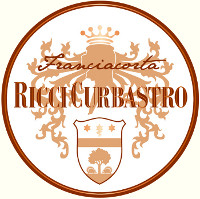
|
|
Franciacorta Rosé Brut |
|
| Ricci Curbastro (Lombardy, Italy) | |
| Grapes: Pinot Noir (80%), Chardonnay (20%) | |
| Price: € 18.00 | Score: |
| Franciacorta Rosé Brut shows a pale onion skin color and nuances of pale pink, very transparent, fine and persistent perlage. The nose denotes intense, clean, pleasing and refined aromas which start with hints of banana, cherry and raspberry followed by aromas of cyclamen, bread crust, yeast, tangerine, hazelnut, apple and hawthorn. The mouth has good correspondence to the nose, an effervescent and crisp attack, however balanced by alcohol, good body, intense flavors, agreeable. The finish is persistent with flavors of raspberry, apple and cherry. Franciacorta Rosé Brut referments in bottle on its lees for about 36 months. | |
| Food Match: Pasta with fish, Roasted fish, Dairy products, Sauteed white meat | |
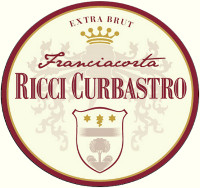
|
|
Franciacorta Extra Brut 2005 |
|
| Ricci Curbastro (Lombardy, Italy) | |
| Grapes: Chardonnay (50%), Pinot Noir (50%) | |
| Price: € 16.70 | Score: |
| This Franciacorta Extra Brut shows a pale straw yellow color and nuances of greenish yellow, very transparent, fine and persistent perlage. The nose reveals intense, clean, pleasing, refined and elegant aromas which start with hints of banana, apple and bread crust followed by aromas of hawthorn, yeast, plum, pineapple, tangerine, hazelnut, grapefruit and butter. The mouth has good correspondence to the nose, a crisp and effervescent attack, however balanced by alcohol, good body, intense flavors, agreeable. The finish is persistent with flavors of banana, grapefruit and hazelnut. This Franciacorta Extra Brut referments in bottle on its lees for at least 42 months. | |
| Food Match: Roasted fish, Roasted white meat, Stuffed pasta, Fried fish, Broiled crustaceans | |
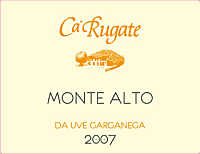
|
|
Soave Classico Monte Alto 2007 |
|
| Ca' Rugate (Veneto, Italy) | |
| Grapes: Garganega | |
| Price: € 18.70 | Score: |
| Soave Classico Monte Alto shows a brilliant straw yellow color and nuances of straw yellow, very transparent. The nose denotes intense, clean, pleasing, refined and elegant aromas that start with hints of apple, plum and almond followed by aromas of citrus fruits, pineapple, chamomile, hawthorn, medlar, pear, vanilla and grapefruit. The mouth has good correspondence to the nose, a crisp attack and however balanced by alcohol, good body, intense flavors, agreeable. The finish is persistent with flavors of apple, plum and almond. Soave Classico Monte Alto ages in barrique for about 8 months. | |
| Food Match: Pasta with mushrooms, Mushrooms soups, Roasted and stewed fish, Roasted white meat | |
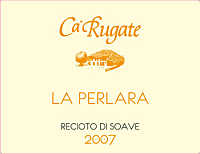
|
|
Recioto di Soave La Perlara 2007 |
|
| Ca' Rugate (Veneto, Italy) | |
| Grapes: Garganega | |
| Price: € 25.00 - 50cl | Score: |
| Recioto di Soave La Perlara shows an intense golden yellow color and nuances of golden yellow, transparent. The nose denotes intense, clean, pleasing, refined and elegant aromas which start with hints of raisin, dried apricot and almond followed by aromas of quince jam, peach jam, candied fruits, vanilla, citrus fruits peel, dried fig, honey and nail polish. The mouth has good correspondence to the nose, a sweet and round attack, however balanced by alcohol, good body, intense flavors, pleasing crispness. The finish is persistent with flavors of raisin, dried apricot and almond. Recioto di Soave La Perlara ages for 12 months in cask. | |
| Food Match: Hard cheese, Confectionery, Dried fruit tarts | |
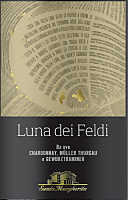
|
|
Luna dei Feldi 2008 |
|
| Santa Margherita (Veneto, Italy) | |
| Grapes: Chardonnay, Müller Thurgau, Gewürztraminer | |
| Price: € 9.70 | Score: |
| Luna dei Feldi shows a pale golden yellow color and nuances of straw yellow, very transparent. The nose denotes intense, clean, pleasing and refined aromas that start with hints of grape, pineapple and litchi followed by aromas of peach, apple, white rose, grapefruit and sage. The mouth has good correspondence to the nose, a crisp attack and however balanced by alcohol, good body, intense flavors, pleasing roundness. The finish is persistent with flavors of grape, peach and apple. Luna dei Feldi ages in steel tanks. | |
| Food Match: Fish and crustacean appetizers, Mushroom soups, Risotto with crustacean | |
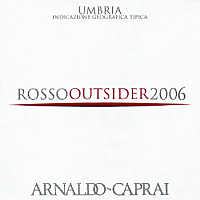
|
|
Rosso Outsider 2005 |
|
| Arnaldo Caprai (Umbria, Italy) | |
| Grapes: Merlot (50%), Cabernet Sauvignon (50%) | |
| Price: € 30.00 | Score: |
| Rosso Outsider shows an intense ruby red color and nuances of ruby red, little transparency. The nose reveals intense, clean, pleasing, refined and elegant aromas which start with hints of black currant, black cherry and plum followed by aromas of violet, vanilla, chocolate, blueberry, mace, tobacco, leather and eucalyptus. The mouth has good correspondence to the nose, a tannic attack and however balanced by alcohol, full body, intense flavors, agreeable. The finish is persistent with flavors of black currant, black cherry and plum. Rosso Outsider ages for 18 months in barrique followed by at least 8 months in bottle. | |
| Food Match: Game, Roasted meat, Stewed and braised meat, Hard cheese | |
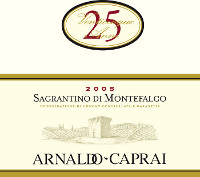
|
|
Sagrantino di Montefalco 25 Anni 2005 |
|
| Arnaldo Caprai (Umbria, Italy) | |
| Grapes: Sagrantino | |
| Price: € 55.00 | Score: |
| Sagrantino di Montefalco 25 Anni shows a deep ruby red color and nuances of ruby red, little transparency. The nose reveals intense, clean, pleasing, refined and elegant aromas which start with hints of blackberry, black cherry and violet followed by aromas of vanilla, plum, blueberry, tobacco, chocolate, leather, graphite, cardamom, mace and menthol. The mouth has excellent correspondence to the nose, a tannic attack and however balanced by alcohol, full body, intense flavors. The finish is very persistent with long flavors of blackberry, plum and black cherry. Sagrantino di Montefalco 25 Anni ages for 24 months in barrique followed by 6 months of aging in bottle. | |
| Food Match: Game, roasted meat, Braised and stewed meat, Hard cheese | |
News |
|
In this section are published news and information about events concerning the world of wine and food. Whoever is interested in publishing this kind of information can send us a mail to our address.
|
AquavitaeReview of Grappa, Distillates and Brandy |
|
|
| Distillates are rated according to DiWineTaste's evaluation method. Please see score legend in the "Wines of the Month" section. |
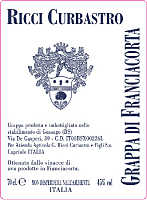
|
|
Grappa di Franciacorta |
|
| Ricci Curbastro (Lombardy, Italy) | |
| (Distiller: Distilleria Peroni Maddalena) | |
| Raw matter: Pomace of Franciacorta | |
| Price: € 19.75 - 70cl | Score: |
| This grappa is colorless, transparent and crystalline. The nose reveals intense, clean, pleasing and refined aromas of apple, hawthorn, pear, hazelnut and licorice, with almost imperceptible alcohol pungency. In the mouth has intense flavors, with perceptible alcohol pungency which tends to dissolve rapidly, good correspondence to the nose, balanced sweetness, pleasing roundness. The finish is persistent with flavors of apple, hazelnut and licorice. This grappa is produced with a steam operated alembic still. Alcohol 45%. | |
Wine Parade |
|
|
| The best 15 wines according to DiWineTaste's readers. To express your best three wines send us an E-mail or fill in the form available at our WEB site. |
| Rank | Wine, Producer | |
|---|---|---|
| 1 |
| Aglianico del Vulture La Firma 2004, Cantine del Notaio (Italy) |
| 2 |
| Arkezia Muffo di San Sisto 2004, Fazi Battaglia (Italy) |
| 3 |
| Barolo Bussia 2001, Prunotto (Italy) |
| 4 |
| Collio Bianco Col DisŰre 2004, Russiz Superiore (Italy) |
| 5 |
| Merlot 2004, Castello delle Regine (Italy) |
| 6 |
| Barolo Sorano 2004, Alario (Italy) |
| 7 |
| Villa Gresti 2004, Tenuta San Leonardo (Italy) |
| 8 |
| Sagrantino di Montefalco Passito 2004, Adanti (Italy) |
| 9 |
| Sangiovese di Romagna Superiore Riserva Thea 2005, Tre Monti (Italy) |
| 10 |
| Sagrantino di Montefalco Collepiano 2003, Arnaldo Caprai (Italy) |
| 11 |
| Moscato d'Asti 2007, Vignaioli di S. Stefano (Italy) |
| 12 |
| Blanc des Rosis 2006, Schiopetto (Italy) |
| 13 |
| San Leonardo 2001, Tenuta San Leonardo (Italy) |
| 14 |
| Sagrantino di Montefalco 25 Anni 2005, Arnaldo Caprai (Italy) |
| 15 |
| Amarone della Valpolicella Classico Vigneto Monte Sant'Urbano 2004, Speri (Italy) |
| |||||||
Privacy Policy | |||||||


| Copyright © 2002-2024 Antonello Biancalana, DiWineTaste - All rights reserved |
| All rights reserved under international copyright conventions. No part of this publication and of this WEB site may be
reproduced or utilized in any form or by any means, electronic or mechanical, without permission in writing from DiWineTaste. |